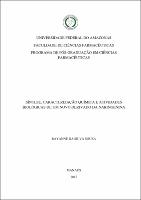| ???jsp.display-item.social.title??? |


|
Please use this identifier to cite or link to this item:
https://tede.ufam.edu.br/handle/tede/5946| ???metadata.dc.type???: | Dissertação |
| Title: | Síntese, caracterização química e atividades biológicas de um novo derivado da Naringenina |
| ???metadata.dc.creator???: | Souza, Rayanne da Silva  |
| ???metadata.dc.contributor.advisor1???: | Lima, Emerson Silva |
| ???metadata.dc.description.resumo???: | Investir no desenvolvimento de novas terapias preventivas contra a progressão de doenças crônicas é essencial, visto que essas enfermidades compartilham etiologias comuns como a inflamação e estresse oxidativo. Flavonoides como a naringenina tem sido objeto de vários estudos na prevenção, controle e tratamento de doenças crônicas. O objetivo deste trabalho foi sintetizar uma nova entidade química e, a partir desta, explorar suas características químicas e físico-químicas e suas atividades biológicas. A ACD41 foi sintetizada a partir da reação de condensação entre a naringenina e aminoguanidina. Sua estrutura química foi elucidada por meio das técnicas de ESI-MS, MS-MS, RMN e FTIR e aspectos físico-químicos estudados utilizando TG, DSC, DTA e DRX. As atividades biológicas exploradas contemplaram os ensaios relacionados ao estresse oxidativo, glicação e inflamação. A ACD41 apresentou-se como um sólido cristalino, com rendimento de 81%, massa molecular de 328,33 g/mol, tempo de retenção de 12,1 minutos na analise por CLAE e com menor resistência térmica comparada à naringenina. A ACD41 apresentou baixa citotoxicidade com CI50 superior a 1000 μg/mL em macrófagos humanos (THP-1) e 767,4 ± 18,71 μg/mL em fibroblastos humanos (MRC-5). Apresentou atividade sequestrante contra os radicais ABTS+ (CI50 = 5,26 ± 0,10 μg/mL) e DPPH (CI50 = 8,33 ± 0,49 μg/mL). Reverteu os níveis de ROS e preservou a integridade da membrana mitocondrial em THP-1. Nos ensaios de glicação in vitro, a ACD41 inibiu a formação de AGEs pelas vias oxidativa (CI50 = 2,58 ± 1,67 μg/mL) e não oxidativa (CI50 = 72,23 ± 2,28 μg/mL). Em macrófagos ativados por LPS, inibiu a produção de TNF-α nas concentrações de 5 e 10 μg/mL. A ACD41 inibiu em 87,95% a produção de hidroperóxido pela LOX e nos estudos in silico interagiu com a enzima COX-2, apresentando uma energia de ligação igual a -10.3 kcal/mol. O presente estudo, pela primeira vez, descreve a molécula (2E)-2-[5,7-diidroxi-2-(4-hidroxifenil)-2,3-dihidro-4H-cromen-4-ilideno]hidrazina carboximi- damida e demonstra o potencial antioxidante, antiglicante e anti-inflamatório desta nova entidade química, a qual pode ser promissora no desenvolvimento de novas terapias para doenças crônicas. |
| Abstract: | Investing in the development of new preventive therapies against the progression of chronic diseases is essential, since these diseases share common aetiologies such as inflammation and oxidative stress. Flavonoids such as naringenin have been the subject of several studies in the prevention, control and treatment of chronic diseases. The objective of this work was to synthesize a new chemical entity and, from this, to explore its chemical and physicochemical characteristics and its biological activities. ACD41 was synthesized from the condensation reaction between naringenin and aminoguanidine. Its chemical structure was elucidated using ESI-MS, MS-MS, NMR and FTIR techniques, and physicochemical aspects studied using TG, DSC, DTA and XRD. The biological activities explored included the trials related to oxidative stress, glycation and inflammation. ACD41 was presented as a crystalline solid, with 81% yield, 328.33 g / mol molecular mass, retention time of 12.1 minutes in HPLC analysis and with lower thermal resistance compared to naringenin. ACD41 showed low cytotoxicity with IC50 greater than 1000 μg / mL in human macrophages (THP-1) and 767.4 ± 18.71 μg / mL in human fibroblasts (MRC-5). It presented sequestering activity against the radicals ABTS+ • (IC 50 = 5.26 ± 0.10 μg / mL) and DPPH• (IC 50 = 8.33 ± 0.49 μg / mL). It reversed ROS levels and preserved mitochondrial membrane integrity in THP1. In the in vitro glycation assays, ACD41 inhibited the formation of AGEs by oxidative (IC 50 = 2.58 ± 1.67 μg / mL) and non-oxidative (IC 50 = 72.23 ± 2.28 μg / mL). In LPS-activated macrophages, it inhibited the production of TNF-α at concentrations of 5 and 10 μg / mL. ACD41 inhibited the production of hydroperoxide by 87.95% by LOX and in the in silico studies it interacted with the COX-2 enzyme, presenting a binding energy equal to -10.3 kcal / mol. The present study describes for the first time the molecule (2E) -2- [5,7-dihydroxy-2- (4-hydroxyphenyl) -2,3-dihydro-4H-chromen-4-ylidene] hydrazine carboxymidinedide And demonstrates the antioxidant, anti-inflammatory and anti-inflammatory potential of this new chemical entity, which may be promising in the development of new therapies for chronic diseases. |
| Keywords: | Flavonoides Naringenina Estresse oxidativo Glicação |
| ???metadata.dc.subject.cnpq???: | CIÊNCIAS DA SAÚDE: FARMÁCIA |
| Language: | por |
| ???metadata.dc.publisher.country???: | Brasil |
| Publisher: | Universidade Federal do Amazonas |
| ???metadata.dc.publisher.initials???: | UFAM |
| ???metadata.dc.publisher.department???: | Faculdade de Ciências Farmacêuticas |
| ???metadata.dc.publisher.program???: | Programa de Pós-graduação em Ciências Farmacêuticas |
| Citation: | SOUZA, Rayanne da Silva. Síntese, caracterização química e atividades biológicas de um novo derivado da Naringenina. 2017. 83 f. Dissertação (Mestrado em Ciências Farmacêuticas) - Universidade Federal do Amazonas, Manaus, 2017. |
| ???metadata.dc.rights???: | Acesso Aberto |
| ???metadata.dc.rights.uri???: | http://creativecommons.org/licenses/by-nc-nd/4.0/ |
| URI: | http://tede.ufam.edu.br/handle/tede/5946 |
| Issue Date: | 27-Jun-2017 |
| Appears in Collections: | Mestrado em Ciências Farmacêuticas |
Files in This Item:
| File | Description | Size | Format | |
|---|---|---|---|---|
| Dissertação_Rayanne_Souza_PPGCF.pdf | 2.97 MB | Adobe PDF |  Download/Open Preview |
This item is licensed under a Creative Commons License





